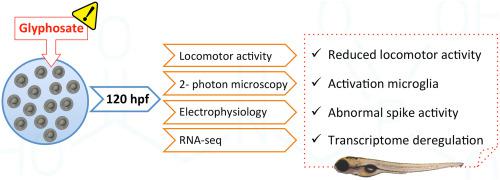Chemosphere ( IF 8.1 ) Pub Date : 2020-12-04 , DOI: 10.1016/j.chemosphere.2020.128986 Isabel Forner-Piquer 1 , Adèle Faucherre 2 , Julia Byram 1 , Marine Blaquiere 1 , Frederic de Bock 1 , Laurence Gamet-Payrastre 3 , Sandrine Ellero-Simatos 3 , Etienne Audinat 1 , Chris Jopling 2 , Nicola Marchi 1

|
The presence of glyphosate represents a debated ecotoxicological and health risk factor. Here, zebrafish larvae were exposed, from 1.5 to 120 hours post-fertilization, to a broad concentration range (0.05 to 10.000 μg/L) of glyphosate to explore its impact on the brain. We evaluated morphology, tracked locomotor behavior and neurophysiological parameters, examined neuro-glio-vascular structures, and outlined transcriptomic deregulations by RNA sequencing.
At the concentration range tested, glyphosate did not elicit gross morphological changes. Next, behavioral analysis revealed a significant decrease in locomotor activity following exposure to 1000 μg/L, or higher. In parallel, midbrain electrophysiological recordings indicated abnormal spike activity in zebrafish larvae exposed to 1000 μg/L. Subsequently, we asked whether the observed neurophysiological outcome could be secondary to brain structural modifications. To this end, we used transgenic zebrafish and in vivo 2-photon microscopy to examine the effects of the behavior-modifying concentration of 1000 μg/L, comparing to 0.1 μg/L and control. We ruled out the presence of cerebrovascular and neuronal malformations. However, we observed microglia morphological modifications at low and high glyphosate concentrations, including the presence of amoeboid cells suggestive of activation. Lastly, RNAseq analysis showed the deregulation of transcript families implicated in neuronal physiology, synaptic transmission or inflammation, as evaluated at the two selected glyphosate concentrations.
In zebrafish larvae, behavioral and neurophysiological defects occur only after exposure to high glyphosate concentrations while, at cellular and transcript levels, pathological elements can be detected in response to low doses. The prospective applicability to ecotoxicology and a possible extension to health vulnerability are discussed.
中文翻译:

剂量范围草甘膦对斑马鱼幼虫运动行为、神经元活动、胶质脑血管结构和转录调控的差异影响
草甘膦的存在是一个有争议的生态毒理学和健康风险因素。在这里,斑马鱼幼虫在受精后 1.5 至 120 小时内暴露于广泛浓度范围(0.05 至 10.000 μg/L)的草甘膦中,以探索其对大脑的影响。我们评估了形态学,跟踪了运动行为和神经生理学参数,检查了神经胶质细胞血管结构,并通过 RNA 测序概述了转录组失调。
在测试的浓度范围内,草甘膦没有引起明显的形态变化。接下来,行为分析显示,暴露于 1000 μg/L 或更高浓度后,运动活动显着下降。与此同时,中脑电生理记录表明,暴露于 1000 μg/L 浓度的斑马鱼幼虫出现异常尖峰活动。随后,我们询问观察到的神经生理学结果是否可能继发于大脑结构的改变。为此,我们使用转基因斑马鱼和体内 2 光子显微镜来检查 1000 μg/L 行为改变浓度的影响,并与 0.1 μg/L 和对照进行比较。我们排除了脑血管和神经元畸形的存在。然而,我们观察到低和高草甘膦浓度下小胶质细胞形态的改变,包括暗示激活的变形虫细胞的存在。最后,RNAseq 分析显示与神经元生理学、突触传递或炎症有关的转录物家族的失调,在两个选定的草甘膦浓度下进行评估。
在斑马鱼幼虫中,仅在暴露于高浓度草甘膦后才会出现行为和神经生理缺陷,而在细胞和转录水平上,可以检测到低剂量的病理因素。讨论了生态毒理学的预期适用性以及健康脆弱性的可能扩展。











































 京公网安备 11010802027423号
京公网安备 11010802027423号